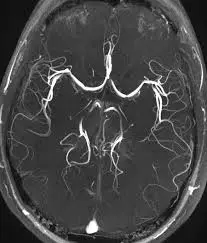How to Interpret Angiography MRIs: 3 Essential Techniques
Understanding angiography MRIs is crucial for diagnosing and treating vascular conditions effectively. This guide introduces you to the MRI's advantages over traditional angiograms and explains three key techniques for interpreting these detailed images.
Understanding Angiography MRIs
An angiography MRI provides a comprehensive view of blood vessels, offering detailed images of arteries, veins, and vascular structures. This section outlines what angiography MRIs are and their advantages for diagnosing various conditions.

What Do Angiography MRIs Show?
- Vascular Detail: Superior imaging of arteries and veins.
- Flow Dynamics: Clear visualization of blood flow, useful in diagnosing blockages or aneurysms.
- Soft Tissue Context: Shows surrounding tissues for comprehensive analysis.
- Disease Detection: More effective in identifying vascular diseases and anomalies.
When Will You Get One?
- Stroke Symptoms: Especially if other imaging tests are inconclusive.
- Vascular Disease: Such as aneurysms or arterial blockages.
- Pre-surgical Planning: Provides detailed anatomy for surgical planning.
- Monitoring Vascular Conditions: Ideal for assessing changes over time in chronic vascular diseases.
Techniques to Interpret Angiography MRIs
Interpreting angiography MRIs involves a deeper understanding of advanced imaging techniques. Here are three techniques for professionals at different levels of expertise.
1. Utilizing X-ray Interpreter
X-ray Interpreter now extends its AI-driven analysis to MRI images. The process ensures precision:
- Registration: Register on X-ray Interpreter to access AI analysis for MRIs.
- Uploading MRIs: Upload your angiography MRI images.
- Reviewing Interpretation: Receive the AI-generated interpretation and download your report.
- Professional Consultation: Always advisable to consult with medical professionals for comprehensive understanding.
Please check out our get started guide.
2. Using ChatGPT Plus
ChatGPT Plus now supports MRI image analysis with its latest GPT-4V model, offering detailed and interactive insights:
- Subscription: Subscribe to ChatGPT Plus for advanced image analysis features.
- Uploading MRIs: Interface with GPT-4V on OpenAI to upload your MRI images.
- Requesting Analysis: Engage with the model for a thorough analysis.
- Review and Confirmation: Assess and refine the analysis as needed.
- Professional Validation: Validation by medical experts is recommended.
Read more on our post about using ChatGPT Plus for MRI interpretation.
Alternatively, as several other AI models with vision capabilities emerge, you can also try other models, such as Grok by xAI, Claude by Anthropic, Gemini by Google Deepmind.
3. Mastering MRI Interpretation Yourself
For healthcare professionals aiming to enhance their MRI reading skills, self-learning is invaluable:
- Education: Pursue advanced training in MRI interpretation.
- Practice: Regular practice under expert guidance.
- Resources: Utilize advanced imaging books and online courses.
- Feedback: Seek feedback to refine skills.
- Continuous Learning: Engage in ongoing education to stay current with imaging techniques.
Recommended Resources for Self-Learning:
-
Magnetic Resonance Angiography (MRA) - RadiologyInfo.org: Comprehensive guide on the purpose, procedure, and benefits of MRA, including detailed explanations and visual aids for better understanding.
-
MR Angiography - Radiopaedia.org: An in-depth article detailing MR angiography techniques, clinical applications, and example cases with annotated images to enhance learning.
-
Magnetic Resonance Angiography (MRA) - Johns Hopkins Medicine: Provides an overview of MRA, including preparation, risks, and what to expect during and after the procedure, along with patient-centric explanations.
Comparative Analysis
Choosing the right technique for interpreting angiography MRIs is vital for accurate diagnosis. This section compares the three methods:
| Criteria | X-ray Interpreter | ChatGPT Plus | Self-Reading |
|---|---|---|---|
| Accuracy | High (AI-based)1 | High (AI-based)1 | Varies (Skill-dependent) |
| Ease of Use | Easy | Moderate | Challenging |
| Cost | Starting from $2.50 per image | $20 per month | Free (excluding educational costs) |
| Time Efficiency | Fast | Moderate to Fast | Slow to Moderate |
| Learning Curve | Low | Low to Moderate | High |
| Additional Resources | Provided | Partially Provided (through OpenAI) | Self-sourced |
Each method has its strengths and weaknesses, with AI options providing rapid and precise interpretations, while self-reading encourages in-depth learning for medical professionals.
Conclusion
Angiography MRI interpretation is critical for diagnosing complex vascular conditions. This guide presents three techniques suited to different professional needs and skill levels. AI methods offer quick, precise interpretations, while self-learning is geared towards those seeking in-depth knowledge.
When selecting a technique, consider your level of expertise, the need for timely interpretation, and the resources available. Ethical and legal standards must always be maintained to ensure patient safety and confidentiality.
Related Articles
Resources and Further Learning
For further exploration and understanding of angiography MRI interpretation, consider the following resources:
-
Magnetic Resonance Angiogram (MRA) - Cleveland Clinic: Detailed information on the procedure, uses, and preparation for an MRA, helping patients understand what to expect and how to prepare.
-
Magnetic Resonance Angiography - MedlinePlus: Provides a comprehensive overview of MRA, including indications, procedure details, and potential risks, aimed at patients and healthcare professionals.
-
3 Top Diseases Diagnosed by Magnetic Resonance Angiography - Houston MRI: Discusses key diseases diagnosed with MRA, including aneurysms, strokes, and renal artery stenosis, highlighting the importance of MRA in clinical diagnostics.